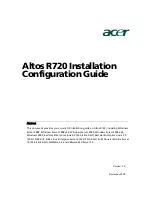
This menu only allows the deconfiguration of an entire book; it does not allow the manual
deconfiguration of half a book. If half a book has been configured by the system (Partially
deconfigured), it can be manually reconfigured using this menu.
In the previous example menu, each line shows two books and indicates whether they are configured,
deconfigured, or partially deconfigured.
To enable or disable Memory Repeat Gard, use menu option 77 of the Memory
Configuration/Deconfiguration Menu. The default is enabled.
To enable or disable runtime recoverable error repeat gard, use option 78 of the Memory
Configuration/Deconfiguration Menu. The default is enabled.
The failure history of each book is retained. If a book with a history of failures is brought back online by
disabling Repeat Gard, it remains online if it passes testing during the boot process. However, if Repeat
Gard is enabled, the book is taken offline again because of its history of failures.
The four inner memory books, if present, are listed first, if present. The memory books are shown in the
following order of physical location code:
1
U1.18-P1-M2
2
U1.18-P1-M3
3
U1.18-P1-M7
4
U1.18-P1-M6
v
Power Control Network Utilities Menu
POWER CONTROL NETWORK UTILITIES MENU
1. Lamp Test for all Operator Panels
2. Display I/O Type
Not Supported
3. Change I/O Type
4. Collect & display SPCN trace data
5. Start SPCN Flash Update
6. Display Power Subsystem FRU Code Levels
98. Return to Previous Menu
0>
–
Lamp Test for All Operator Panels
Selecting this option tests the media drawer operator panel’s indicators by causing them to blink on
and off for approximately 30 seconds.
–
Change I/O Type
Use this option to change the I/O type of the primary I/O book after a service action or configuration
change if the I/O type is incorrect. If this option is chosen, you will be asked to make the following
entries:
- For the I/O drawer address, type
1
.
- For the I/O type, type
98
.
If either value is not valid, a failure message displays on the console. Press Enter to return to the
Power Control Network Utilities Menu.
–
Collect & display SPCN trace data
728
Eserver
pSeries 670 Service Guide
Summary of Contents for pSeries 670
Page 1: ...pSeries 670 Service Guide SA38 0615 03 ERserver...
Page 2: ......
Page 3: ...pSeries 670 Service Guide SA38 0615 03 ERserver...
Page 12: ...x Eserver pSeries 670 Service Guide...
Page 16: ...xiv Eserver pSeries 670 Service Guide...
Page 18: ...xvi Eserver pSeries 670 Service Guide...
Page 324: ...Yes Go to Step 154A 14 on page 302 304 Eserver pSeries 670 Service Guide...
Page 718: ...698 Eserver pSeries 670 Service Guide...
Page 848: ...L3 Cache Shorts Test Step 4 828 Eserver pSeries 670 Service Guide...
Page 849: ...L3 Cache Shorts Test Step 5 Chapter 9 Removal and Replacement Procedures 829...
Page 851: ...L3 Cache Shorts Test Step 2 Chapter 9 Removal and Replacement Procedures 831...
Page 853: ...L3 Cache Shorts Test Step 4 Chapter 9 Removal and Replacement Procedures 833...
Page 854: ...L3 Cache Shorts Test Step 5 834 Eserver pSeries 670 Service Guide...
Page 971: ...7040 Model 671 Media Subsystem 1 2 3 4 5 6 7 8 9 10 Chapter 10 Parts Information 951...
Page 973: ...Power and SCSI Cables to the Media Subsystem 1 2 3 5 4 6 Chapter 10 Parts Information 953...
Page 986: ...966 Eserver pSeries 670 Service Guide...
Page 990: ...970 Eserver pSeries 670 Service Guide...
Page 1018: ...998 Eserver pSeries 670 Service Guide...
Page 1020: ...1000 Eserver pSeries 670 Service Guide...
Page 1028: ...1008 Eserver pSeries 670 Service Guide...
Page 1031: ......
















































